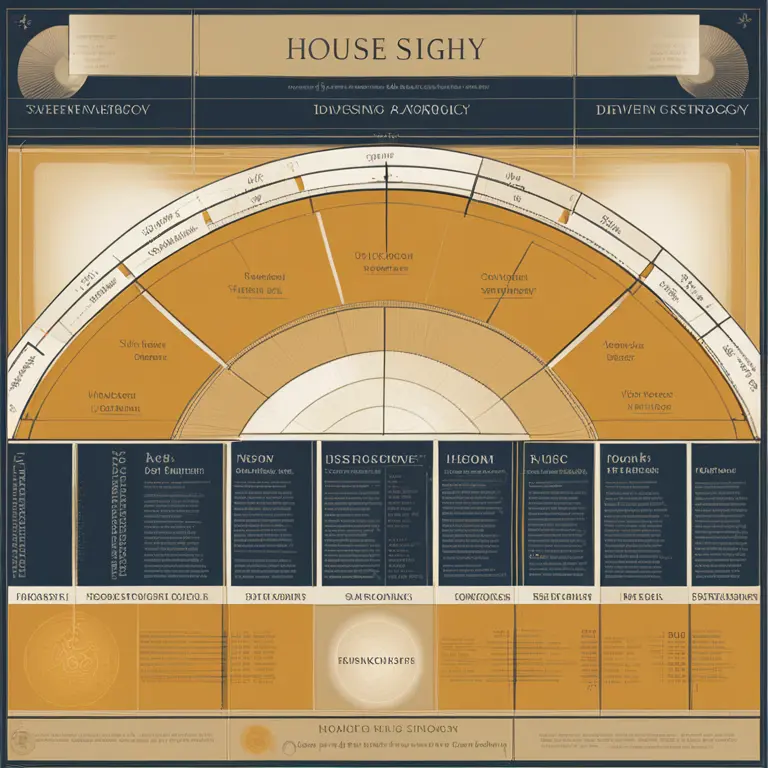
Calculating Astrological Houses in Your Birth Chart
Discover the methodology behind determining astrological houses in a birth chart, an essential factor in interpreting personal horoscopes.
article by Priya Deshmukh
The Basics of Astrological Houses
Astrological houses are a key component in the architecture of a birth chart. Each house represents a different area of life, such as relationships, career, or personal wealth. While the zodiac signs provide insight into the 'how' of our behavior, the houses reveal the 'where' — the various stages upon which our life stories unfold. Contrary to popular belief, houses are not the same as zodiac signs, though they do share similar divisions. There are twelve houses in a natal chart, just as there are twelve signs in the zodiac.

Setting the Stage: Ascendant and Midheaven
The process of determining your astrological houses begins with the Ascendant, also known as the rising sign, which marks the cusp of the first house. It's the zodiac sign that was rising on the eastern horizon at the exact moment of your birth. Another critical point is the Midheaven, or the tenth house cusp, indicating the highest point that the Sun reaches on the day of birth. The positions of these two points are essential as they set the layout for the rest of the houses.

Time and Location: The Essentials
To calculate the astrological houses accurately, one must have their exact time and place of birth. This data allows an astrologer to construct a birth chart tailored to the individual, as it can significantly alter the division and size of the houses. A difference of just a few minutes can change the ruling planets of the houses, thereby influencing the interpretation of one’s horoscope. In the era post-2024, precision in birth timing continues to be crucial for accurate astrological readings.

Methods of House Division
There are various systems used for dividing the celestial sphere into the twelve houses. The Placidus system, named after the 17th-century astrologer Placidus de Titis, is the most commonly used method in Western astrology. It factors in the time it takes for each degree of the ecliptic to rise above the eastern horizon. Another method is the Whole Sign system, wherein the entire sign that contains the Ascendant becomes the first house, and the rest follow suit. Modern astrologers might use the Equal House system or the Koch method, depending on preference and tradition.
The Influence of Hemisphere and Latitude
The location's latitude where a person is born has a profound impact on the astrological houses. In locations with higher latitudes, the Placidus system can result in some houses being significantly larger than others. For individuals born in regions close to the poles, the astute astrologer might switch to Whole Sign or Equal House systems to avoid disproportionate houses which can complicate interpretation. As the Earth continues its journey through the cosmos, understanding how location affects natal charts remains a significant study in astrology.
Celestial Mathematics: House Cusps
The cusp of a house is the line that marks the beginning of a house. To find these points, astrologers divide the sky based on the Ascendant and Midheaven, either equally or by using complex trigonometry that considers the Earth’s tilt and the ecliptic's curve. After finding the house cusps, the planets are placed into the houses based on where they were in relation to the zodiac at the time of birth. This placement contributes deeply to the individual's nuanced astrological profile.
Published: 1/17/2024
Modified: 1/17/2024
More predictions
Come back here soon to learn more about yourself and your future


The Influence of Astrology in Human Lives
Delve into the impact of astrology on daily life, relationships, and personal growth, and understand how celestial alignments can guide our decisions and self-awareness.


Zodiac Compatibility: Cosmic Matches That Align
Discover which astrology signs mesh well together and why some celestial pairings resonate on a deeper level, paving the way for harmony.


The Astrological Signs of August: Leo and Virgo
Delve into the cosmic influences of August as the vibrant Leo energy transitions into meticulous Virgo in the astrological calendar.